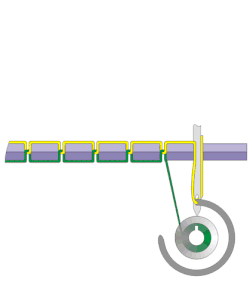A sewing machine uses many techniques for interlacing of thread but popular one is Lockstitch.
Lockstitch
Lockstitch is the familiar stitch performed by most household sewing machines and most industrial "single needle" sewing machines from two threads, one passed through a needle and one coming from a bobbin or shuttle. Each thread stays on the same side of the material being sewn, interlacing with the other thread at each needle hole by means of a bobbin driver. As a result, a lockstitch can be formed anywhere on the material being sewn; it does not need to be near an edge.

The lockstitch uses two threads, an upper and a lower. Lockstitch is so named because the two threads, upper and lower, "lock" (entwine) together in the hole in the fabric which they pass through. The upper thread runs from a spool kept on a spindle on top of or next to the machine, through a tension mechanism, through the take-up arm, and finally through the hole in the needle. Meanwhile the lower thread is wound onto a bobbin, which is inserted into a case in the lower section of the machine below the material.
To make one stitch, the machine lowers the threaded needle through the cloth into the bobbin area, where a rotating hook (or other hooking mechanism) catches the upper thread at the point just after it goes through the needle. The hook mechanism carries the upper thread entirely around the bobbin case, so that it has made one wrap of the bobbin thread. Then the take-up arm pulls the excess upper thread (from the bobbin area) back to the top, forming the lockstitch. Then the feed dogs pull the material along one stitch length, and the cycle repeats.
 | |
No comments:
Post a Comment